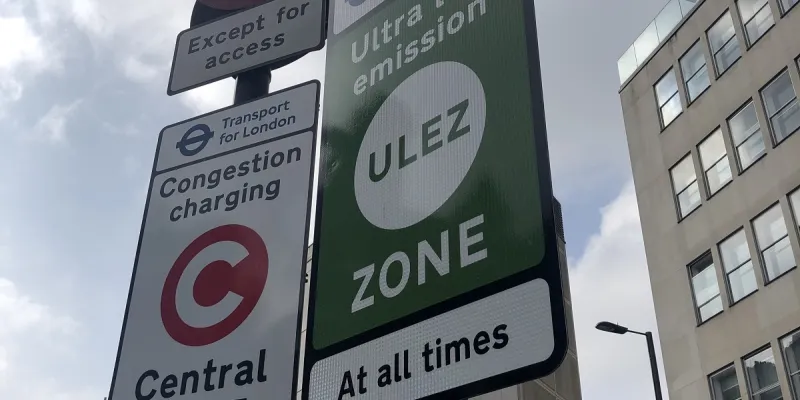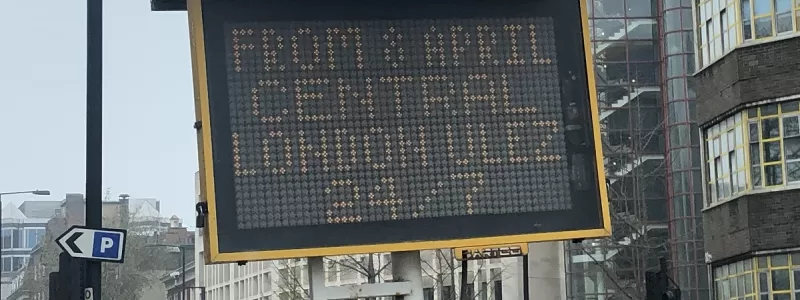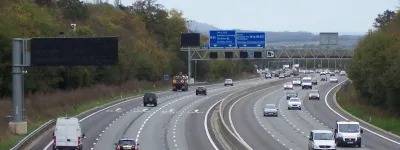Efforts to improve London's air quality just took another step. The Ultra Low Emission Zone is now in force.
Air quality in London is a problem. Official estimates suggest that 50% of all the stuff that makes the city's air so unpleasant comes from road traffic, so it's no surprise that the Mayor of London, Sadiq Khan, is targeting the roads in his quest to clean up the air.
Two years ago we reported on the introduction of the T-Charge (or Toxicity Charge). As of today, the temporary T-Charge is abolished, and replaced with its permanent successor, the Ultra Low Emission Zone, or ULEZ.
What's the difference?
The T-Charge was a bolt-on to the London Congestion Charge that caused more polluting vehicles to pay more. The ULEZ is a new and entirely separate scheme, which gives it one critical difference: the Congestion Charge operates during business hours, Monday to Friday, but the ULEZ operates 24 hours a day, every day of the year.
Transport for London (TfL) now operate three entirely separate and distinct road user charging schemes. For the sake of clarity, these are:
- The Congestion Charge, which operates within the Inner Ring Road during business hours, Monday to Friday, and applies to all vehicles crossing the cordon. The daily charge is £11.50.
- The Low Emission Zone, which covers virtually the whole of Greater London and operates at all times, but only applies to heavy goods vehicles and large buses. The charges start at £100 and climb steeply from there.
- The new Ultra Low Emission Zone, which only operates within the Inner Ring Road but applies at all times and to all vehicles. The daily charge is £12.50 for most vehicles but can be up to £100 for some HGVs.
The three charges are exclusive of each other - paying one will not cover you for the rest. Because the ULEZ is a new and separate charge, it has a whole separate set of signs marking the boundaries of the zone, duplicating the ones that are already in place for the Congestion Charge. London's Inner Ring Road has just gained an awful lot of new signs - not that it was short of them to begin with.
Who pays the ULEZ?
Any vehicle that does not meet the appropriate emissions standards. This is based on the details about your vehicle that are registered with the DVSA. In general, petrol cars registered after 2005 are exempt; however, the restrictions on diesel vehicles are much stricter and owners of many diesel vehicles registered prior to 2016 will have to pay the charge if they drive within the ULEZ.
TfL have a useful vehicle checker that will tell you whether your vehicle is exempt or not.
There are plenty of angry voices around today talking about how the ULEZ does not apply to buses, taxis, council vehicles and a range of other people (including the coastguard). This is, of course, true, and in many places is being rolled out by people who consider the ULEZ a form of taxation that will have little environmental impact.
There are two points to consider in relation to that idea, which appears reasonably widespread. The first is that the ULEZ is not meant to clean up emissions from buses, taxis or other public service vehicles. Other measures are being taken to tackle emissions from those; the ULEZ is one part of the Mayor's strategy for cleaner air and it's the part that is specifically about private road transport. It's no surprise that it only affects private vehicles.
The second is that it's unlikely to actually be paid by a great many people. Most Londoners have known about the ULEZ for some time, and many of those who travel into Central London have already traded in their old vehicle for one that is exempt. Others, for whom driving in to Central London was only marginally economical before, will just no longer do so. And that is, really, the point, isn't it?
The Mayor's office doesn't want to collect huge sums of money from the ULEZ. It wants fewer polluting vehicles in Central London. If people switch to compliant vehicles and avoid paying, then it's working. Indeed, the Mayor's office has actually launched their own scrappage scheme to subsidise the purchase of ULEZ-compliant vehicles for small businesses and charities. A further scrappage scheme, for private individuals on lower incomes, was announced in February but hasn't yet started.
It goes without saying that many people won't be swayed by those arguments and will continue to be angry about the unfairness of another charge that affects motorists. We trust their views will be well represented in the comments below this article very shortly.
How do I pay the ULEZ?
TfL's website now has a single payment interface for all three charges, so you can simply enter your vehicle registration and it will tell you which charges are due. They have also launched a new mobile app called "TfL Pay to Drive in London". Other forms of payment, such as over the phone, will also be available.
Only the beginning
If you're not a fan of emissions-based charges, look away now, because you won't like what comes next.
In London, TfL have now announced the dates for two future expansions of the ULEZ. In October 2020, the Low Emission Zone will be stepped up to match the emissions standards of the ULEZ, requiring much cleaner lorries and buses within the whole of Greater London.
Then, on 25 October 2021, the boundaries of the Ultra Low Emission Zone will widen out to encompass everything within the North and South Circular Roads - a vast area of the metropolis. The effect of that will be complicated, much more so than this initial scheme, and we'll explore that in more detail in a future blog post. It's likely that the biggest effects of the ULEZ are yet to be felt, for this reason.
It's also extremely likely that the emissions requirements for the zone will be tightened progressively over time, so that not all vehicles that are exempted now will always remain so.
Outside of London, many of the UK's other major cities are facing similar problems with air quality and several are looking at, or actively planning, Ultra Low Emission Zones of their own. Leeds and Birmingham may be next.
Say what?
Perhaps the most intriguing question of all is what people will call the new zone. Do you spell it out, you-ell-ee-zed? Is it the you-lez?
Here at Roads.org.uk, we're flying the flag for oo-lez. Try it out and let us know what you think in the comments.
Comments
My own car is allowed as it's a Euro 6 diesel. However this is just another way of making shedloads of money, especially from the penalties for non-payment. Filthy stinking old diesel buses and also black-cabs are exempt. Surely these should be charged a huge amount when one sees the clouds of smoke they emit.
As I wrote in the article, the point is not to deal with emissions from buses and taxis. The Mayor's office has more direct control over those and they are covered by other programmes to reduce emissions. The ULEZ is specifically about emissions from private vehicles.
I don't believe for a moment that the ULEZ is going to bring in huge amounts of money. It's going to people who currently bring polluting vehicles into London to either invest in a newer vehicle or reconsider their journey.
London had the largest trolleybus network in the world at one time with 1700 buses operating. It was all scrapped and diesel buses put in their place. Many other cities in the UK operated them too. Only when I see those wires going up again and electric buses back on our streets, will I believe any politician is serious about pollution. Have a look at Arnhem to see what is possible
"I don't believe for a moment that the ULEZ is going to bring in huge amounts of money".
Well, it is expected to bring in about £165 million a year for the first few years. Hardly small change. Of course it is one of the legal ways available to the Mayor to make up the loss of the government grant to Transport for London for the buses, the other being the massive fines income from traffic contraventions on roads controlled by TfL.
Another way to make up the loss would be to do what is generally done elsewhere in the country, i.e. scrap all but the most essential bus routes and reduce their frequency.
The ULEZ cannot possibly be designed make a lot of money.
Think about it. The more money the ULEZ makes, the worse it's doing, because if it's making a lot of money that means a lot of polluting vehicles are still entering the zone, exactly what we don't want, and if that turns out to be the case it won't be long before it's scrapped and replaced with something different.
Taxis and service buses are different because the Mayor is actually able to simply mandate them to use cleaner vehicles, so they don't need the ULEZ to incentivize them.
What stinking old diesel buses? Pretty sure all the ones in the ULEZ zone are now Euro VI or at worst Euro V, with a few electric ones now in service.
Similarly, a lot of the new hybrid taxis are already in service
A regressive tax that penalises the drivers least able to afford new cars. Maybe the government should instead mandate car manufacturers to make retrofit kits to fix the emissions.... Especially renault nissan 1.5 dci engines... they're awful. The euro six ones wouldnt get euro 5 emissions in the real world.
And people in that position would struggle to get new cars insured at anything less than a king's ransom (assuming they can get insurance at all), especially in inner London.
As it stands, folk on lower incomes are actively priced out of property ownership, education, job opportunities, and affordable transport, and now they're being priced out of vehicle ownership itself.
I will bet actual money that at some point within the next 10-20 years, a strict 'two adults per room' policy will be introduced for low-income earners and the unemployed, and where surplus space exists, extra people will be moved in without the householder's consent, on the grounds that overcrowded properties are better for the environment than comfortable ones. Of course, this would take place after the advancement and general acceptance of post-normal democracy, or as you or I would call it, vote-rigging.
The 2021 extension will have a massive effect, as it covers where people LIVE, as opposed to the inner London scheme (which apart from a few well off people) only affects people who drive into London. Masses of surburbia will be captured, especially in North London, the car on the drive used to take the kids ti school, or only at weekends.
Other than van drivers, who actually drives into Inner London congestion charge area in an old car anyway?
I think good public transport is also important as effective private vehicle deterrent. The public transport in the current ULEZ is pretty good, but the same might not be the case in the extended zone -- the recent shambles of Crossrail and GOBLIN may cause considerable worries.
I think the reason people object to exempting buses and taxis while imposing it on many cars is not a failure to understand that the ULEZ is only part of the strategy, but that nothing seems to be being done about buses. I agree that the TfL can deal with bus emissions, but they are not. Most TfL buses emit visible clouds of soot when accelerating, they idle in traffic jams (and the nature of the routes mean that they often idle for long periods in jams in the worst pollution hotspots), they idle at bus stops (which are often sited very close to schools and areas with high pedestrian traffic, so as to serve those areas), and they are not consistently Euro VI vehicles.
What people object to is the fact that TfL's response to vehicles they do not pay for is to impose taxes verging on fines (an overnight visit, at £25, is half the level of some fixed penalties for dangerous offences at £50, and for a 5 day a week commute is £62.50, more than the fine for driving a dangerous vehicle), and their response to anything where they pay the bill is to try and get a few more years out of outdated, polluting vehicles, with a 100% exemption. The New Routemaster, which was being built up to 2017, is a Euro V engined bus and more polluting than the vehicle it replaced. This is the main bus used in the highly polluted central area.
I got stung for £320 during Christmas and New Year because I entered the wrong digit/number on the ULEZ registration website (mixed up letter O with number 0). Be careful folks!!
I like many others have moved out from London to the surrounding home counties. I appreciate that air quality/pollution is a problem that needs to be addressed but do object most strongly that I am facing a penalty charge to attend the cemetery to tend loved ones graves or a funeral.
The link to the "useful vehicle checker" in the main body of the article appears to have gone dead now.
The vehicle checker is still online, but seems to have a new URL: https://tfl.gov.uk/modes/driving/check-your-vehicle/




Well there needs to be a nation wide scrappage scheme for this to be effective, that will allow nearly all private diesel cars and vans that dont meet Euro 6 to be taken off the road. Especially if the owners of these vehicles live in major population areas.
The scrappage scheme should also apply to privately owned petrol vehicles that dont meet the Euro 4 requirements.
I expect that only vehicles of historic value (classics), or vehicles special enough to an owner not to scrap will remain. At least though those two types of vehicles wont actually end up being driven much, so will be less likely to enter such ULEZs.